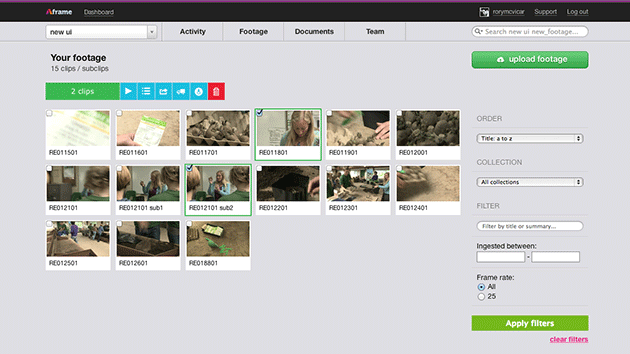New Version of Cloud Video Production Service Features Metadata Export for Avid, FCP, and Premiere Pro
Aframe, a web-based cloud platform for post-production, sharpened its focus on efficient editing workflow today with a new version of its technology that adds support for Panasonic's AVC implementation and proxy workflow as well as metadata export directly into Avid Media Composer, Apple Final Cut Pro, and Adobe Premiere Pro.
The new metadata export system is called Edit Flow, and it allows pertinent, timecode-specific metadata to be exported from the cloud in the form of a small AAF or XML file that goes along with the footage and can be used inside the supported editing systems. Jeff Bedell, a longtime Avid software engineer who won a 1993 Emmy for his work on the original Media Composer, implemented the Edit Flow features.
Comments, logging, subclips, and clip collections can be transferred to an NLE and relinked with the original media, automatically retaining all of the changes that were made in the Aframe system and improving efficiency in the early stages of production, when producers, directors and others piece together and annotate rough cuts that must be quickly assessed and finessed by the project's editors.
Aframe's new AVC support enables proxy workflows by allowing users to work with a lightweight, camera-generated proxy file in Aframe, then relink their edit decisions and metadata with the full-resolution footage in the NLE.
The new Aframe 2.0 also includes a streamlined user interface that mimics an iOS app, making it easier for non-tech users to work with footage in the system, and a new API library to encourage third-party integration. As an example, Aframe's API will allow existing platforms for the creation of deliverables to plug directly into Aframe, simplifying that process.
Given the Edit Flow feature, and its closer integration between Aframe and NLE software, we asked Aframe CEO David Peto if the company was considering integration with other post-production applications, such as VFX software. He professed some interest in shot-management software (specifically The Foundry's Hiero), but said in the short term the new API platform will allow Aframe's clients and third-party developers to extend the reach of Aframe's technology. "Our next big push is API integrations," Peto said. "Customers will be able to build their own workflow on the Aframe platform."
Working in the cloud has clear benefits in light of natural disasters like last year's Hurricane Sandy, which threw many businesses offline completely as floodwaters took out crucial infrastructure in lower Manhattan and elsewhere. Peto noted that Aframe's New York data centers survived the storm as others failed. "People don't really understand how hardcore our infrastructure is," he said. "All of the servers are ours, and everything is backed up with three copies in separate locations."
Given the immensity of Aframe's storage capacity, we wondered if customers would someday be able to use Aframe as an archiving system, providing access to footage from completed projects as well as current work, and Peto said that is under consideration. "We may be announcing an archive solution, in a while, that would provide constant access, even to deleted footage."
Aframe has been up and running in London since 2010, but only expanded its private network to the U.S. in 2012, establishing data centers in New York and Los Angeles. Earlier this year, it announced details of a relationship with Panasonic that saw the company's reseller network begin selling Aframe licenses on the company's behalf. Pricing is dependent on a number of variables, but accounts start at $50/month per user and increase from there.
For more information: www.aframe.com
Did you enjoy this article? Sign up to receive the StudioDaily Fix eletter containing the latest stories, including news, videos, interviews, reviews and more.











Leave a Reply